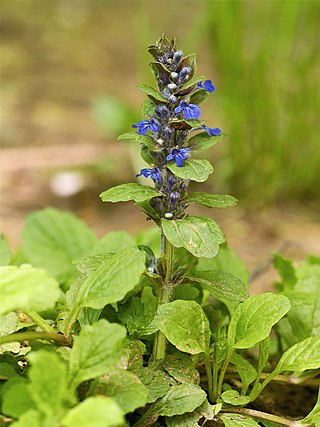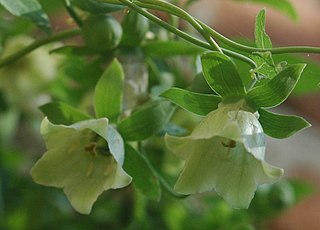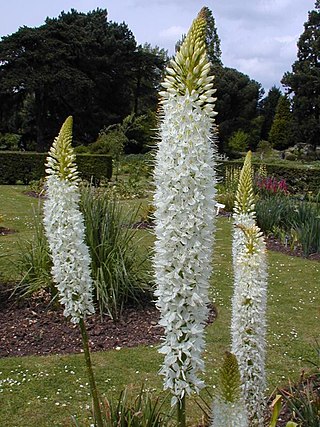
Ajuga, also known as bugleweed, ground pine, carpet bugle, or just bugle, is a genus of flowering plants in the Ajugeae tribe of the mint family Lamiaceae. There are over 60 species of annual or perennial, mostly herbaceous plants. They are native to Europe, Asia, Africa, and Australia.

Salvia subgenus Perovskia is a group of species within the flowering plant genus Salvia, which prior 2017 were treated as the separate genus Perovskia. Members of the group are native to southwestern and central Asia. It includes the garden plant Russian sage.

Gagea is a large genus of spring flowers in the lily family. It is found primarily in Eurasia with a few species extending into North Africa and one species in North America.

Leymus is a genus of plants in the grass family Poaceae (Gramineae). It is widespread across Europe, Asia, and the Americas.

Melissa is a genus of perennial herbs in the family Lamiaceae. Its species are native to Europe and Asia but cultivated and naturalized in many other places. The name Melissa is derived from the Greek word μέλισσα (mélissa) meaning "honeybee", owing to the abundance of nectar in the flowers. The stems are square, like most other plants in the mint family. The leaves are borne in opposite pairs on the stems, and are usually ovate or heart-shaped and emit a lemony scent when bruised. Axillary spikes of white or yellowish flowers appear in the summer.

Codonopsis is a genus of flowering plant in the family Campanulaceae. As currently recognized, Codonopsis includes two other groups sometimes separated as distinct genera, i.e. Campanumoea and Leptocodon. The enlarged genus Codonopsis is widespread across eastern, southern, central, and southeastern Asia, including China, Japan, the Russian Far East, Kazakhstan, the Indian Subcontinent, Iran, Indochina, Indonesia, etc.

Leonurus (motherwort) is a genus of flowering plants in the family Lamiaceae. It is native to Europe and Asia, naturalized in New Zealand, Hawaii, New Caledonia, and much of North and South America.

Lallemantia is a genus of flowering plants in the family Lamiaceae. It is named after the German botanist Julius Léopold Eduard Avé-Lallemant.

Lagochilus is a genus of the mint family that contains Turkistan mint.

The large-eared pika is a species of small mammal in the family Ochotonidae. It is found in mountainous regions of Afghanistan, Tibet, Bhutan, India, Kazakhstan, Kyrgyzstan, Nepal, Pakistan and Tajikistan where it nests among boulders and scree.

Kobresia is a genus of plants in the sedge family. They are sometimes called bog sedges. These perennial sedges are quite similar to Carex species in appearance. The genus is widespread across much of Europe, Asia and North America, with many species native to the Himalayas.

Eremurus is a genus of deciduous perennial flowers in the family Asphodelaceae. They are also known as the foxtail lilies or desert candles. They are native to eastern Europe in, and temperate Asia from Turkey to China, with many species in Central Asia.

Elsholtzia is a plant genus in the Lamiaceae. It is widespread across much of temperate and tropical Asia from Siberia south to China, Northeastern India, Indonesia, etc. The genus was named in honour of the Prussian naturalist Johann Sigismund Elsholtz.
- Elsholtzia amurensisProb. - Amur region of Russia
- Elsholtzia angustifolia(Loes.) Kitag. - Korea, Manchuria
- Elsholtzia argyiH.Lév. - southern China, Vietnam
- Elsholtzia beddomeiC.B.Clarke ex Hook.f. - Myanmar, Thailand
- Elsholtzia blanda(Benth.) Benth. - southern China, Himalayas, Indochina, Sumatra, Viet Nam
- Elsholtzia bodinieriVaniot - Guizhou, Yunnan
- Elsholtzia byeonsanensisM.Kim - South Korea
- Elsholtzia capituligeraC.Y.Wu - Tibet, Sichuan, Yunnan
- Elsholtzia cephalanthaHand.-Mazz. - Sichuan
- Elsholtzia ciliata(Thunb.) Hyl. - widespread across Siberia, Russian Far East, China, India, Himalayas, Japan, Korea, Indochina
- Elsholtzia communis(Collett & Hemsl.) Diels - Myanmar, Thailand, Vietnam
- Elsholtzia concinnaVautier - Nepal, Sikkim, Bhutan
- Elsholtzia cyprianii(Pavol.) C.Y.Wu & S.Chow - central + southern China
- Elsholtzia densaBenth. - India, Pakistan, Nepal, Bhutan, Afghanistan, Kyrgyzstan, Tajikistan, Tibet, Xinjiang, China, Mongolia
- Elsholtzia eriocalyxC.Y.Wu & S.C.Huang - southern China
- Elsholtzia eriostachya(Benth.) Benth. - China, Tibet, Himalayas
- Elsholtzia feddeiH.Lév - China, Tibet
- Elsholtzia flavaBenth. - China, Himalayas
- Elsholtzia fruticosa(D.Don) Rehder - China, Himalayas, Tibet, Myanmar
- Elsholtzia glabraC.Y.Wu & S.C.Huang - China
- Elsholtzia griffithiiHook.f - Myanmar, Assam
- Elsholtzia hallasanensisY.N.Lee - Jeju-do Island in Korea
- Elsholtzia heterophyllaDiels - Yunnan, Myanmar
- Elsholtzia hunanensisHand.-Mazz. - southern China
- Elsholtzia kachinensisPrain - southern China, Myanmar, Thailand
- Elsholtzia litangensisC.X.Pu & W.Y.Chen - Sichuan
- Elsholtzia luteolaDiels - Sichuan, Yunnan
- Elsholtzia minimaNakai - Jeju-do Island in Korea
- Elsholtzia myosurusDunn - Sichuan, Yunnan
- Elsholtzia nipponicaOhwi - Japan
- Elsholtzia ochroleucaDunn - Sichuan, Yunnan
- Elsholtzia oldhamiiHemsl. - Taiwan
- Elsholtzia pendulifloraW.W.Sm - Yunnan, Thailand, Vietnam
- Elsholtzia pilosa(Benth.) Benth. - China, Himalayas, Myanmar, Vietnam
- Elsholtzia pubescensBenth. - Java, Bali, Lombok, Timor, Sulawesi
- Elsholtzia pygmaeaW.W.Sm. - Yunnan
- Elsholtzia rugulosaHemsl - southern China, Myanmar, Thailand
- Elsholtzia serotinaKom - northern China, Japan, Korea, Primorye
- Elsholtzia soulieiH.Lév. - Sichuan, Yunnan
- Elsholtzia splendensNakai ex F.Maek. - China, Korea
- Elsholtzia stachyodes(Link) Raizada & H.O.Saxena - Indian Subcontinent, China, Myanmar
- Elsholtzia stauntoniiBenth. - northern China
- Elsholtzia strobilifera(Benth.) Benth. - China, Himalayas, Myanmar
- Elsholtzia winitianaCraib - Yunnan, Guangxi, Laos, Thailand, Vietnam

Allium atrosanguineum is an Asian species of onion native to China, Siberia, Mongolia, and Central Asia. It grows high in the mountains at elevations of 2400–5400 m.

Allium carolinianum is a species of onions native to central and southern Asia. It grows in sunlit slopes at elevations of 3000–5000 m.

Ziziphora are a genus of annual or perennial herbs or subshrubs in the family Lamiaceae. Ziziphora has aromatic leaves; they are found in open and often xeric habitats in Southern and Eastern Europe, North-West Africa and Asia to the Himalayas and Altai mountains.

Askellia is a genus of Asian and North American plants in the tribe Cichorieae within the family Asteraceae.

High-Mountain Asia (HMA) is a high-elevation geographic region in central-south Asia that includes numerous cordillera and highland systems around the Tibetan Plateau, encompassing regions of East, Southeast, Central and South Asia. The region was orogenically formed by the continental collision of the Indian Plate into the Eurasian Plate.

The taxonomy of Tulipa places the genus in the family Liliaceae, and subdivides it as four subgenera, and comprises about 75 species.


















